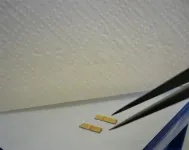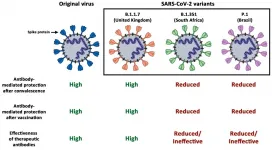Automated embryo selection system might rise likelihood of success in treating infertility
The AI-based system photographs the embryos every five minutes, processes the data of their development and notifies any anomalies observed. This increases the likelihood of choosing the most viable and healthy early-stage embryo for IVF procedures.
2021-03-25
(Press-News.org) The team of researchers at Kaunas University of Technology (KTU), Lithuania applied artificial intelligence (AI) methods to evaluate data of human embryo development. The AI-based system photographs the embryos every five minutes, processes the data of their development and notifies any anomalies observed. This increases the likelihood of choosing the most viable and healthy early-stage embryo for IVF procedures. The innovation was developed in collaboration with Esco Medical Technologies, a manufacturer of medical equipment.
Almost one in six couples face infertility; about 48.5 million couples, 186 million individuals worldwide are inflicted. Europe has one of the lowest birth rates in the world, with an average of just 1.55 children per woman.
The most effective form of assisted reproductive technology is in vitro fertilisation (IVF) - a complex series of procedures used to help with fertility. However, the success of IVF procedures is closely linked to many biological and technical issues. The fertilisation and in vitro culturing of embryos are dependent upon an environment that should be stable and correct concerning temperature, air quality, light, media pH and osmolality. At the end of this procedure, there are several embryos, which consequently leads to a problem of choosing the best of them that is likely to give the greatest success of pregnancy and should be transferred to the uterus.
"Typically, a healthy embryo progresses consistently through known development stages, has a low percentage of cell fragmentation, and there are other indicators of its healthy development. However, assessing the health of an early-stage embryo from its visual information is not an easy task. That's where the technologies can come to help", says Dr Vidas Raudonis, Professor at the Department of Automation, KTU Faculty of Electrical and Electronics Engineering.
The interdisciplinary team of KTU researchers lead by Dr Raudonis, developed an automated method for early-stage embryo evaluation. The method is based on processing the visual data collected by photographing the developing embryo every five minutes from seven different sides for up to five days. Up to 20,000 images are generated during the image-capturing process. To evaluate them all manually would be an impossible task for the embryologist in charge of the procedure.
"At this stage, the embryologist can rely on the AI algorithm developed by KTU. Our algorithm automatically analyses the photos and marks all the events and anomalies that can affect the successful further development of the embryo. It's important to note that the final decision is made by the embryologist - the AI algorithm is only a tool that allows to objectively justify the decision", Dr Raudonis explains.
He emphasises that due to the rate of embryo development, changes that indicate developmental abnormalities may not be noticed during manual data analysis. AI is trained to notice all the essential features of a healthy embryo in a sequence of photos. Therefore, it can replicate the work of an embryologist, or, to be more exact - to perform the visual inspection of the embryo's development.
Automated embryo development assessment is a new field not only in Lithuania but also in the world. It has been actively developed in the last six years, when the technical possibilities to create more sophisticated AI methods and algorithms emerged. Strong teams of scientists from Israel, Australia, Denmark and other countries are working in this field. More and more clinics all over the world are applying AI-based solutions for assisting infertility treatment.
The technology created by the KTU team is already being used in certain medical facilities in Lithuania. The commercialisation of the solution is facilitated by Esco Medical Technologies, the leading manufacturer of high-quality equipment for IVF procedures.
"My team and I were probably the first in Lithuania to apply AI methods to process data obtained by registering the development of human embryos in incubators. Our first steps towards cooperation with business were small but focused. Now this work is turning not only into scientific products but also into technological solutions", says Dr Raudonis.
INFORMATION:
[Attachments] See images for this press release:

ELSE PRESS RELEASES FROM THIS DATE:
2021-03-25
By offering a microscopic "tightrope" to cells, Virginia Tech and Johns Hopkins University researchers have brought new insights to the way migrating cells interact in the body. The researchers changed their testing environment for observing cell-cell interaction to more closely mirror the body, resulting in new observations of cells interacting like cars on a highway -- pairing up, speeding up, and passing one another.
Understanding the ways migrating cells react to one another is essential to predicting how cells change and evolve and how they react in applications, such as wound healing and drug delivery. In a study published in the Proceedings of the National Academy of Sciences, a team formed by Mechanical Engineering Associate ...
2021-03-25
Scientists of Tomsk Polytechnic University jointly with colleagues from different countries have developed a new sensor with two layers of nanopores. In the conducted experiments, this sensor showed its efficiency as a sensor for one of the doping substances from chiral molecules. The research findings are published in Biosensors and Bioelectronics (IF: 10,257; Q1) academic journal.
The material is a thick wafer with pores of 20-30 nm in diameter. The scientists grew a layer of metal-organic frameworks (MOF) from Zn ions and organic molecules on these thick wafers. The MOF has about 3 nm nanopores only. It plays the role of a trap for molecules, which must be detected.
"This sensor can operate with chiral molecules. Such substances consisting of chiral molecules are a lot among medical ...
2021-03-25
In the future, photovoltaic cells could be "worn" over clothes, placed on cars or even on beach umbrellas. These are just some of the possible developments from a study published in Nature Communications by researchers at the Physics Department of the Politecnico di Milano, working with colleagues at the University of Erlangen-Nuremberg and Imperial College London.
The research includes among its authors the Institute of Photonics and Nanotechnology (IFN-CNR) researcher Franco V. A. Camargo and Professor Giulio Cerullo. It focused on photovoltaic cells made using flexible organic technology. Today's most popular photovoltaic cells, based on silicone technology, are rigid and ...
2021-03-25
The Miscanthus genus of grasses, commonly used to add movement and texture to gardens, could quickly become the first choice for biofuel production. A new study shows these grasses can be grown in lower agricultural grade conditions - such as marginal land - due to their remarkable resilience and photosynthetic capacity at low temperatures.
Miscanthus is a promising biofuel thanks to its high biomass yield and low input requirements, which means it can adapt to a wide range of climate zones and land types. It is seen as a viable commercial option for farmers but yields ...
2021-03-25
Energy models are used to explore different options for the development of energy systems in virtual "laboratories". Scientists have been using energy models to provide policy advice for years. As a new study shows, energy models influence policymaking around the energy transition. Similarly, policymakers influence the work of modellers. Greater transparency is needed to ensure that political considerations do not set the agenda for future research or determine its findings, the researchers demand.
Renewable energies bring many changes, including fluctuations in the energy supply and a more geographically distributed generation system. ...
2021-03-25
A collaborative research project by team of undergraduate students from the University of Exeter's Natural Sciences department has been published in a prestigious academic journal.
Lewis Howell, Eleanor Osborne and Alice Franklin have had their second-year research published in The Journal of Physical Chemistry B.
Their paper, Pattern Recognition of Chemical Waves: Finding the Activation Energy of the Autocatalytic Step in the Belousov-Zhabotinsky Reaction, was a result of their extended experiment work in the Stage 2 module "Frontiers in Science 2".
Their project involved the Belousov-Zhabotinsky chemical reaction - an ...
2021-03-25
March 7, 2021, KAUST, Saudi Arabia - KAUST Assistant Professor of Computer Science Mohamed Elhoseiny has developed, in collaboration with Stanford University, CA, and École Polytechnique (LIX), France, a large-scale dataset to train AI to reproduce human emotions when presented with artwork.
The resulting paper, "ArtEmis: Affective Language for Visual Art," will be presented at the Conference on Computer Vision and Pattern Recognition (CVPR), the premier annual computer science conference, which will be held June 19-25, 2021.
Described as the "Affective Language for Visual Art," ArtEmis's user interface has seven emotional descriptions on average for each image, bringing the total count to over 439K emotional-explained attributions from humans on ...
2021-03-25
While urban agriculture can play a role in supporting food supply chains for many major American cities -- contributing to food diversity, sustainability and localizing food systems -- it is unrealistic to expect rooftop gardens, community plots and the like to provide the majority of nutrition for the population of a metropolis.
That's the conclusion of a team of researchers who analyzed the nutritional needs of the population of Chicago and calculated how much food could be produced in the city by maximizing urban agriculture, and how much crop land would be needed adjacent to the city to grow the rest. The study was the first to evaluate land required to meet ...
2021-03-25
Scientists have shown that SARS-CoV-2, the virus that causes COVID-19, can infect specific cells in the salivary gland in the mouth. The study by researchers from the Wellcome Sanger Institute, National Institutes of Health and the University of North Carolina at Chapel Hill, and their collaborators within the Human Cell Atlas Oral & Craniofacial Network, also discovered that live cells from the mouth were found in saliva, and that the virus was able to reproduce within these infected cells.
The study revealed that salivary gland cells could play a role in transmission ...
2021-03-25
Göttingen, March 25, 2021. Testing and vaccination - these are the pillars on which humanity is trying to get a grip on the Coronavirus pandemic. Although it is taking longer than many had expected, it is believed that it is only a matter of time before we are all vaccinated and thus protected. However, time is also working for the virus, which has now mutated several times, with variants B.1.1.7 from the United Kingdom, B.1.351 from South Africa and P.1 from Brazil spreading rapidly. These viruses have mutations in the so-called spike protein, the structure on the surface of the virus that is responsible for attachment to host cells. At the same time, the spike protein is also the major target of the immune response. Antibodies generated in response to SARS-CoV-2 infection or vaccination ...
LAST 30 PRESS RELEASES:
[Press-News.org] Automated embryo selection system might rise likelihood of success in treating infertility
The AI-based system photographs the embryos every five minutes, processes the data of their development and notifies any anomalies observed. This increases the likelihood of choosing the most viable and healthy early-stage embryo for IVF procedures.




